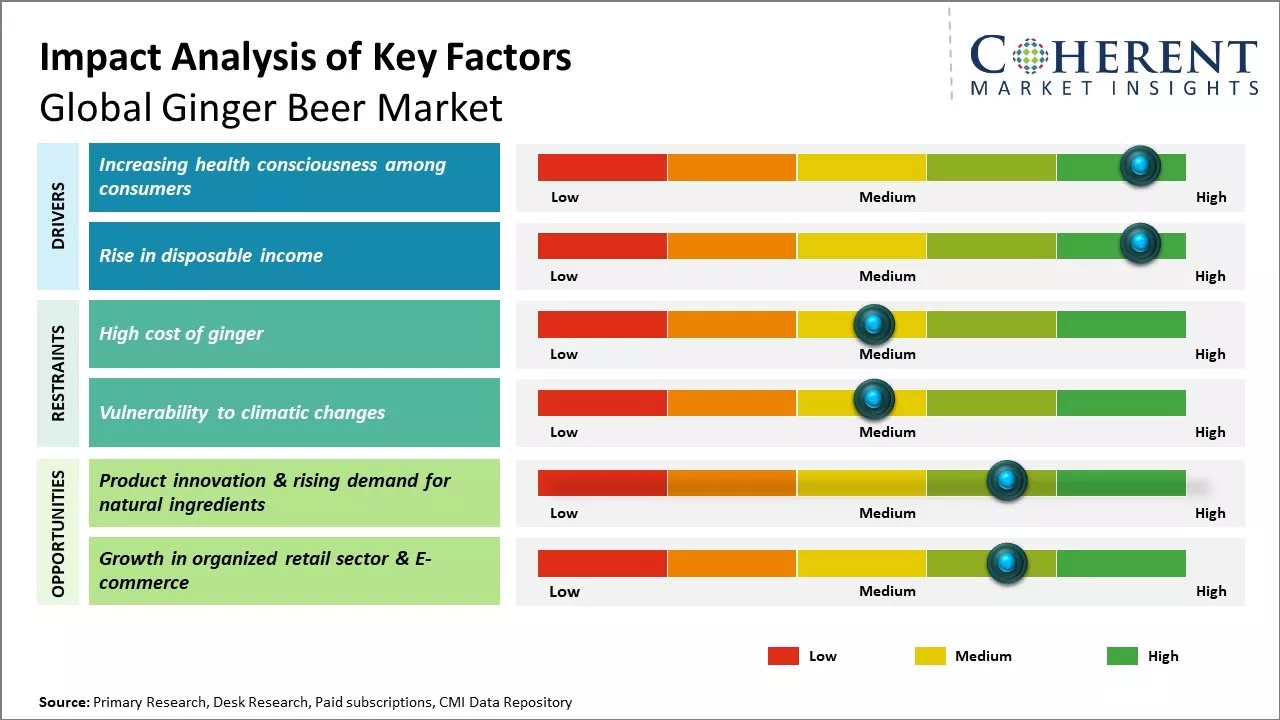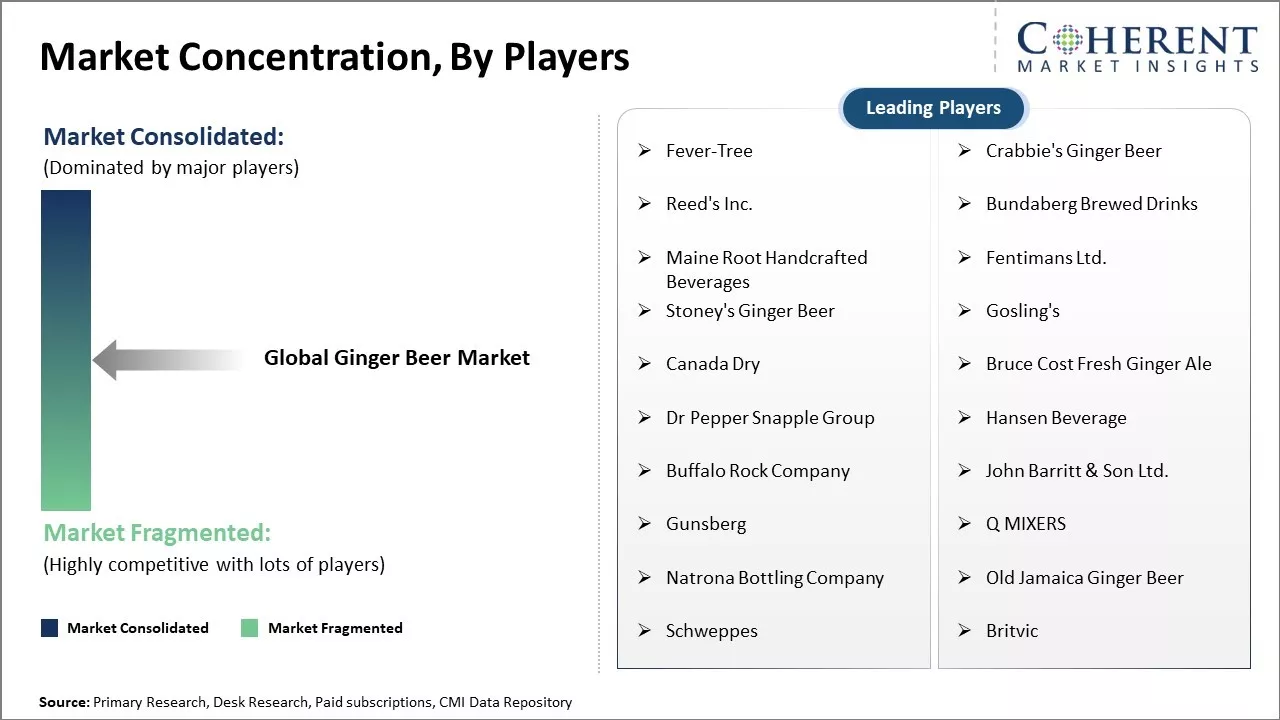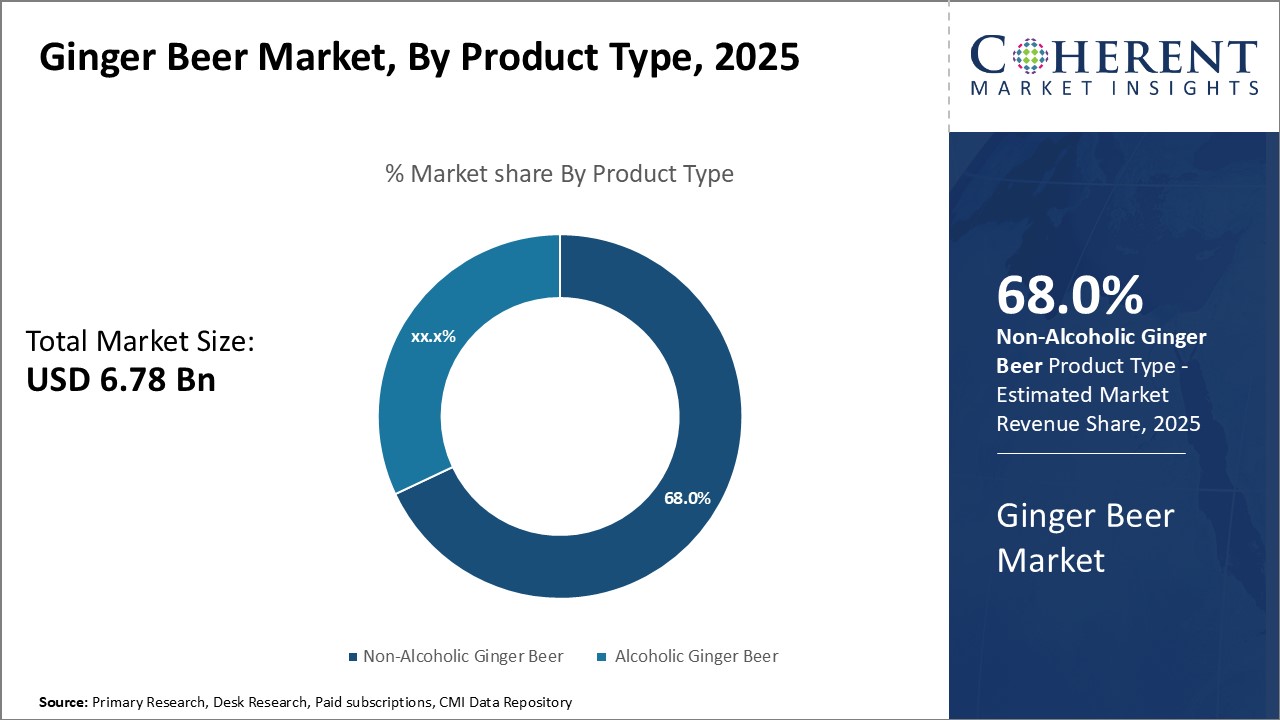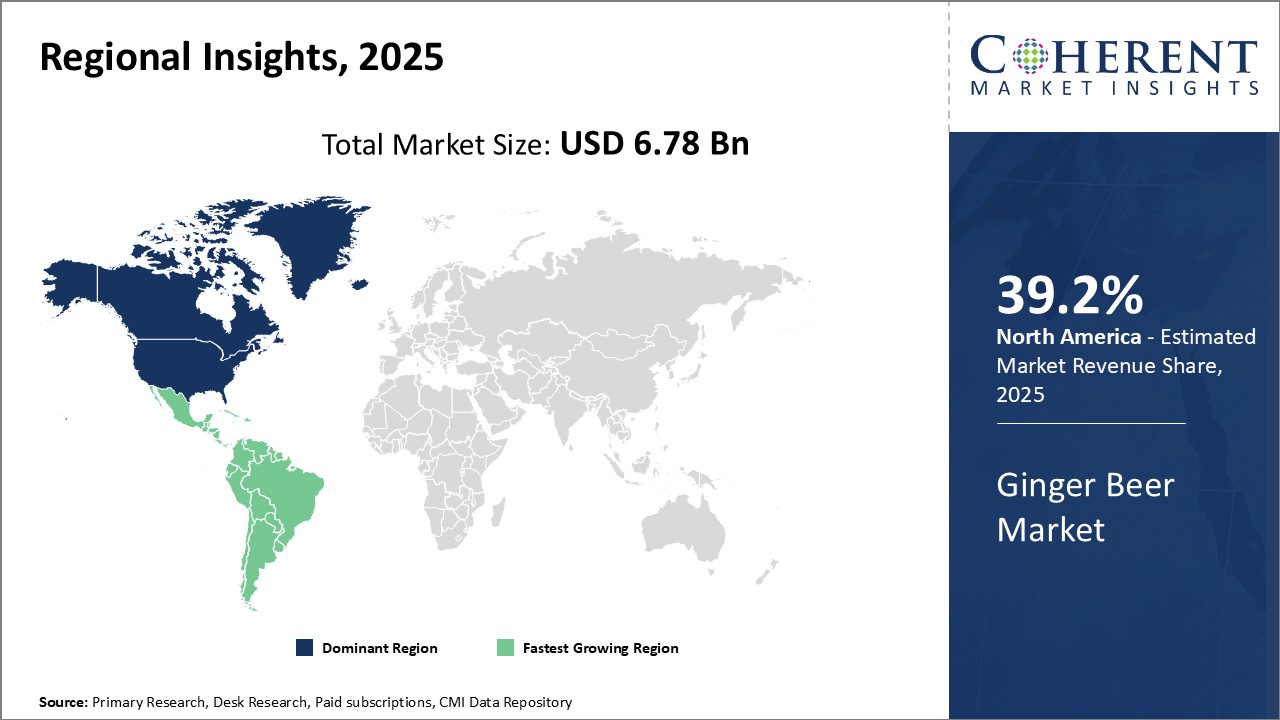Ginger Beer Market Size and Trends
The global ginger beer market is estimated to be valued at USD 6.78 Bn in 2025 and is expected to reach USD 11.11 Bn by 2032, exhibiting a compound annual growth rate (CAGR) of 7.3% from 2025 to 2032.

Discover market dynamics shaping the industry: Download Free Sample
Ginger beer continues to gain popularity among consumers due to its refreshing taste and potential health benefits. The naturally fermented beverage is viewed as a healthier alternative to sugary sodas. Rising awareness about the digestive health benefits of ginger is driving increased consumption of ginger beer worldwide.
Increasing health consciousness among consumers
With change in lifestyle and busy schedule, people are becoming more conscious about their health and diet. There is growing awareness that excessive consumption of carbonated drinks and processed fruit juices have adverse impact on health in the long run. At the same time, the desire to consume variety and explore new flavors never stops. This is where ginger beer comes into play as it offers natural refreshment fulfilling health quotient as well as taste preference.
Ginger is known for its various medicinal properties from ancient times. It helps in digestion and works as natural detoxifier. Modern science also validates traditional medicinal uses of ginger and research proves ginger to have anti-inflammatory, antioxidant, and anti-bacterial qualities. The combined effect makes ginger beneficial for various health issues like cold, flu, nausea, migraine, etc. Consumers are realizing this and preferring beverages with actual health benefiting ingredients over artificially flavored drinks. As ginger beer contains real ginger extract without added color or preservatives, it caters well to growing demand for healthier refreshment options.
Moreover, rising consciousness has led people to opt for diet variants containing lesser sugar content. While regular sodas are high in sugar, ginger beer producers are innovating with low or zero sugar varieties without compromising on taste. Such healthy alternatives are gaining wider acceptance. Lactose intolerant group has also expanded market for ginger beer as dairy-free refreshment choice. Prominent brands such as Q Ginger Beer and other brands are promoting ginger beer for its health attributes through marketing communication targeting health-cautious demographic. Improved accessibility through retailers specializing in natural products and e-commerce further supplements increased consumption.
Market Concentration and Competitive Landscape

Get actionable strategies to beat competition: Download Free Sample
Rise in disposable income
Increase in disposable income allows people to spend on premium goods which they earlier perceived as luxuries. Food and beverage form an important category where people like to upgrade their spending. For instance, according to data by Economics Times in 2024, India's Gross National Disposable Income (GNDI) grew 14.5% in 2022-2023, compared to 18.8% in 2021-2022. Within food and beverage (F&B) sector, the demand for craft and premium drinks has seen particular rise. Earlier, ginger beer was mostly seen as an occasional drink consumed at restaurants or pubs. But growing affluence has made it affordable for regular household consumption.
Due to higher spending power, there is premiumization of shopping habits with people desiring wider choice, better quality and experiential products. They wish to try something distinct from regular soft drinks. Craft ginger beer fits well into this psychographic as a specialty beverage made with natural ingredients like whole ginger slices, cane sugar instead of high fructose corn syrup, and sparkling water. These artisanal production processes come at higher price but customers are willing to pay more for authenticity.
Similarly, consumers now prefer personalized drinking experiences and exploring regional delicacies from across cultures. This propels the demand for international or exotic flavors in ginger beer like lemon grass, honey, and tropical fruits inspired by Caribbean recipes. Since discretionary budget has increased substantially, customers spend additional amount to procure such premium and imported varieties available in specialty stores.
Urban population forming a major chunk of total consumer base are the early adopters for such new indulgences. Growing middle class youth are influencers setting consumption trends through social media platforms where premiumization becomes a social symbol. Overall improvement in living standards hence works favorably for the ginger beer market as people allocate higher funds in their food and beverage budget for upgraded product experiences. This promotes premiumization of entire category.
Key Takeaways from Analyst:
The global ginger beer market is expected to see steady growth over the coming years driven by the rising focus on health and wellness among consumers. In addition, the bold and spicy flavors offered by ginger beer appeal to a wide consumer base looking for unique and premium beverage options. Younger consumers in particular are driving new product innovation and flavors in this space.
North America currently dominates the ginger beer market due to growing popularity. However, Asia Pacific is expected to be the fastest growing regional market. This is because ginger beer ties into traditional uses of ginger in various cuisines and beverages across Asia Pacific. Increased exposure to western drinking trends is also influential.
On the other hand, pricing volatility for ginger raw material is a key restraint to consistent market expansion. Demanding consumer expectations for freshness and quality pose a challenge as well. Additionally, the presence of alternatives like craft sodas, kombucha, and healthier cocktails provide competition.
Nevertheless, emerging opportunities lie in tailoring ginger beer products for specific consumption occasions and innovative package formats. Functional positioning with added wellness benefits can further aid growth. Moreover, celebrity endorsements and creative marketing campaigns help increase product awareness and trial.
Market Challenge - High cost of ginger
One of the key challenges being faced by the global ginger beer market is the high cost of ginger. Ginger is the primary raw material used in the production of ginger beer. However, the cost of ginger has witnessed a significant rise over the past few years due to various factors. Ginger cultivation requires specialized farming techniques and laborers with appropriate skills. The availability of farming land suitable for ginger cultivation is also limited. These factors have contributed to tight supply of ginger in the global market. At the same time, the demand for ginger is increasing globally due to the rising popularity of Asian cuisines and natural health drinks. This imbalance between supply and demand has resulted in inflated ginger prices. For ginger beer manufacturers, the rising ginger costs have negatively impacted their margins. It has become difficult for them to price ginger beer attractively for customers without compromising on profits. If high ginger costs persist, it might discourage investment and innovation in the ginger beer market.
Market Opportunity: Product innovation & rising demand for natural ingredients
The global ginger beer market is poised to benefit substantially from the trend of product innovation and rising preference for natural ingredients among consumers, for instance, In July 2024, Heads of Noosa Brewing Co, a renowned craft brewery based in Australia, proudly announced the release of its inaugural Ginger Beer. This exciting new beverage is crafted using high-quality, Australian-grown ginger, showcasing the brewery's commitment to using local ingredients and supporting Australian agriculture. Ginger beer producers are innovating their products by introducing new flavors based on demand. For example, some manufacturers have developed ginger beer flavors infused with lemon, lime or spices like cinnamon to appeal to varying tastes. At the same time, health-conscious customers are favoring beverages with natural ingredients over highly-processed drinks. This growing demand for natural beverages acts as a major growth driver for the ginger beer industry. Ginger and honey are key natural ingredients present in ginger beer. The manufacturers' emphasis on using natural ingredients without adding preservatives or artificial flavors in their product development strategies has found favor with customers. This focus on product innovation leveraging natural ingredients is expected to open new avenues of growth for the global ginger beer market.

Discover high revenue pocket segments and roadmap to it: Download Free Sample
Insights by product type: Convenience drives growth in the Non-alcoholic segment
In terms of product type, the non-alcoholic ginger beer segment is estimated to dominate the market revenue share, accounting for 68.0% share of the market in 2025, owing to its convenient consumption options. As lifestyles get busier globally, consumers are increasingly valuing products that can be easily enjoyed without compromising on taste or health. Non-alcoholic ginger beer fits well within this trend as it delivers the bold ginger flavor that people love about traditional ginger beer, but without any alcohol content. This makes it suitable for a wider range of occasions and consumption demographics compared to alcoholic varieties.
Families with children particularly favor non-alcoholic ginger beer as it allows everyone to enjoy the refreshing drink together. The no/low alcohol positioning also makes it a popular choice for designated drivers or those watching their alcohol intake. From a health perspective, non-alcoholic ginger beer retains the digestive benefits of real ginger which many consumers seek out. It allows enjoyment of craft sodas and mixer options without added sugar or calories from alcohol. The growing wellness movement has further boosted interest in lower-calorie beverage options with functional ingredients like ginger.
Ease of availability in major retail channels also drives the leadership of the non-alcoholic segment. Most supermarkets devote significant shelf space to non-alcoholic beverages, making these varieties more visible and accessible to casual buyers. Non-alcoholic ginger beer experiences less regulatory restrictions compared to alcoholic products, simplifying distribution. Overall, the combination of suitability for a range of lifestyles, health credentials and widespread accessibility provide tailwinds for the growth of the non-alcoholic ginger beer segment.
Insights by flavor profile: Original flavors resonate most with traditions
In terms of flavor profile, the original/traditional segment is estimated to contribute 36.3% share of the market in 2025, owing to its nostalgic appeal and authenticity. Ginger beer originated as a fermented non-alcoholic drink with robust ginger flavors. The classic original recipe leverages this history to tap into consumers' desire to reconnect with roots and traditions through their beverage choices. Many associate the distinctive zing of original ginger beer with fond memories from childhood such as family trips or cultural celebrations. This nostalgia creates an emotive connection that builds brand loyalty.
While new flavors introduce excitement, traditional ginger beer satisfies a craving for familiar, heritage flavors in an era where traditions are eroding. The defined yet bold taste allows people to confidently share the drink as an introduction to their culture, adding a sense of identity. When indulging in craft sodas or cocktails as a treat, original profile fits the bill for an artisanal ingredient-driven experience over artificially flavored option. Its distinguishable yet subtly balanced taste also works well straight or mixed, lending versatility.
Authenticity matters greatly to an evolving consumer base seeking transparency. Original ginger beer makes no modifications to time-tested recipes, relying solely on high quality ginger to let its natural potency shine through. This purity and lack of extras resonates with those prioritizing naturalness and simplicity in their choices. Altogether, original ginger beer fulfills various modern needs around roots, authenticity and transparency through its traditional flavor foundation.
Insights by distribution channel: Supermarkets create a one-stop-shop
In terms of distribution channel, the supermarkets/hypermarkets segment is estimated to contribute 39.2% share in 2025, due to consolidating multiple shopping missions. As lives accelerate, consumers increasingly value minimizing separate shopping trips across different stores. Supermarkets address this by functioning as a centralized one-stop-shop. Their expansive variety of products from various categories saves valuable time otherwise spent driving between specialty shops.
Within supermarkets, convenient self-serve layouts allow brisk yet thorough purchasing. Dedicated beverage aisles group all drink options side-by-side for effortless comparisons. Familiar supermarket brands serve as a dependable baseline, while new discoveries can be added on impulse from same-aisle adjacencies. This stimulates greater spending across categories during each visit.
Pricing is also competitive at supermarkets using scale to drive costs down. Multi-product baskets incentivize loyalty programs and discounts through frequent accumulated point redemptions. A wide socio-economic customer mix further grows the potential market reach. Coolers maintain product freshness for perishables like ginger beer throughout their shelf life.
Altogether, one-location fulfilment of errands transforms the utilitarian supermarket trip into a leisurely all-in-one experience. Their access to mass audiences cements their role as a dominant ginger beer sales driver. Ongoing improvements to streamline the shopping cycle will amplify their commission proportion in the distribution mix.
Regional Insights

Need a Different Region or Segment? Download Free Sample
North America has established itself as the dominant region in the global ginger beer market over the years. The region is expected to hold 39.2% of the market share in 2025. The U.S. accounts for the major share of the North America ginger beer market owing to high consumption levels. The presence of well-established players like Reed's Inc. and Fever-Tree have significantly boosted craft ginger beer popularity in the country. Moreover, the growing health-conscious consumer base prefers natural mixers like ginger beer over soda counterparts. This has led to ginger beer's widespread availability across conventional grocery stores as well as dedicated beverage sections.
Export activity of American ginger beer brands such as Gosling's Ginger Beer and others has also strengthened North America's peak position. Reed's products, in particular, exhibit a broadening international footprint spanning Canada, the U.K., Ireland and parts of Europe. Other local players are also exploring growth avenues in Latin American countries. The strong brand awareness coupled with superior taste and quality plays an important part in their overseas success. However, higher prices compared to domestic brands act as a minor deterrent.
The Asia Pacific region has emerged as the fastest developing market for ginger beer globally over the past decade. High population coupled with rising incomes has augmented overall beverage consumption in the region. Countries like India and China have additionally witnessed a boom in craft and artisanal beverage startups. This has accelerated the availability of premium products like locally brewed ginger beers.
Local producers in India have gained considerable momentum through novel flavor innovations tailored for the Indian palate. The affinity for strong ginger flavor also gives them a competitive edge over international brands. Meanwhile, Chinese ginger beer manufacturers are investing in sleek packaging and targeting young health-conscious consumers. Additionally, growing expatriate communities and inbound tourism provide them opportunities to expand exports to other Asian markets gradually. While competitive pricing and adaptation to local tastes drive their progress, stringent regulatory frameworks continue to pose challenges.
Market Report Scope
Ginger Beer Market Report Coverage
| Report Coverage | Details | ||
|---|---|---|---|
| Base Year: | 2024 | Market Size in 2025: | USD 6.78 Bn |
| Historical Data for: | 2020 To 2024 | Forecast Period: | 2025 To 2032 |
| Forecast Period 2025 to 2032 CAGR: | 7.3% | 2032 Value Projection: | USD 11.11 Bn |
| Geographies covered: |
|
||
| Segments covered: |
|
||
| Companies covered: |
Fever-Tree, Crabbie's Ginger Beer, Reed's Inc., Bundaberg Brewed Drinks, Maine Root Handcrafted Beverages, Fentimans Ltd., Stoney's Ginger Beer, Gosling's, Canada Dry, Bruce Cost Fresh Ginger Ale, Dr Pepper Snapple Group, Hansen Beverage, Buffalo Rock Company, John Barritt & Son Ltd., Gunsberg, Q MIXERS, Natrona Bottling Company, Old Jamaica Ginger Beer, Schweppes, and Britvic |
||
| Growth Drivers: |
|
||
| Restraints & Challenges: |
|
||
Uncover macros and micros vetted on 75+ parameters: Get instant access to report
Ginger Beer Industry News
- In July 2024, Barritt's Ginger Beer a beer company, proudly marked its 150th anniversary, a significant milestone in the brand's rich history. To celebrate this momentous occasion, Barritt's is launching an exciting new mixer line designed to elevate the drinking experience and cater to the evolving tastes of consumers.
- In July 2024, Heads of Noosa, a renowned beverage company known for its craft beers, proudly announced the launch of its highly anticipated ginger beer. This new addition to its product lineup reflects the company’s commitment to innovation and quality in the beverage industry.
- In March 2024, Sunnyside Drinks Co., a rising star in the beverage industry, announced the upcoming launch of its range of alcoholic ginger beers in the U.K. Set to hit the market this summer, this new product line promises to bring a refreshing twist to the growing demand for craft beverages.
- In 2023, Goslings, renowned for its iconic Black Seal Rum, a drink company, made waves in the beverage industry with the launch of its first-ever flavored ginger beer. Infused with the delightful taste of peach, this new offering from Goslings promises to tantalize taste buds and provide a refreshing twist on the classic ginger beer.
*Definition: The global ginger beer market involves the sale of ginger beer products internationally. Ginger beer is a carbonated beverage made by brewing and fermenting ginger, sugar, yeast and water. It originated in the U.K. and is now popular worldwide. The global ginger beer market provides consumers with a variety of ginger beer options that vary in flavor intensity and sweetness level. The market offers products in different packages catering to the needs of retailers as well as household consumers.
Market Segmentation
- By Product Type Insights (Revenue, USD Bn, 2020 - 2032)
- Non-Alcoholic Ginger Beer
- Alcoholic Ginger Beer
- By Flavor Profile Insights (Revenue, USD Bn, 2020 - 2032)
- Original/Traditional
- Flavored
- Spicy/Extra Ginger
- By Distribution Channel Insights (Revenue, USD Bn, 2020 - 2032)
- Supermarkets/Hypermarkets
- Online Retail
- Specialty Stores
- Bars and Restaurants
- Convenience Stores
- Regional Insights (Revenue, USD Bn 2020 - 2032)
- North America
- U.S.
- Canada
- Latin America
- Brazil
- Argentina
- Mexico
- Rest of Latin America
- Europe
- Germany
- U.K.
- Spain
- France
- Italy
- Russia
- Rest of Europe
- Asia Pacific
- China
- India
- Japan
- Australia
- South Korea
- ASEAN
- Rest of Asia Pacific
- Middle East
- GCC Countries
- Israel
- Rest of Middle East
- Africa
- South Africa
- North Africa
- Central Africa
- North America
- Key Players Insights
- Fever-Tree
- Crabbie's Ginger Beer
- Reed's Inc.
- Bundaberg Brewed Drinks
- Maine Root Handcrafted Beverages
- Fentimans Ltd.
- Stoney's Ginger Beer
- Gosling's
- Canada Dry
- Bruce Cost Fresh Ginger Ale
- Dr Pepper Snapple Group
- Hansen Beverage
- Buffalo Rock Company
- John Barritt & Son Ltd.
- Gunsberg
- Q MIXERS
- Natrona Bottling Company
- Old Jamaica Ginger Beer
- Schweppes
- Britvic
Share
Share
About Author
Yash Doshi is a Senior Management Consultant. He has 12+ years of experience in conducting research and handling consulting projects across verticals in APAC, EMEA, and the Americas.
He brings strong acumen in helping chemical companies navigate complex challenges and identify growth opportunities. He has deep expertise across the chemicals value chain, including commodity, specialty and fine chemicals, plastics and polymers, and petrochemicals. Yash is a sought-after speaker at industry conferences and contributes to various publications on topics related commodity, specialty and fine chemicals, plastics and polymers, and petrochemicals.
Missing comfort of reading report in your local language? Find your preferred language :
Transform your Strategy with Exclusive Trending Reports :
Frequently Asked Questions
EXISTING CLIENTELE
Joining thousands of companies around the world committed to making the Excellent Business Solutions.
View All Our Clients
